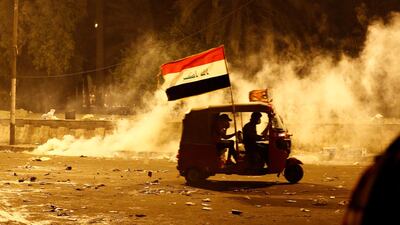Karad Hussein is again on the front lines of the anti-government protests rocking Iraq, not to confront the authorities but as one of an army of tuk-tuk drivers and volunteers helping injured protesters.
“This is our duty. If I didn’t carry them, who would?" says Mr Hussein, 24, in Baghdad’s Tahrir Square. “Is there anyone else who can take them?”
Iraqis have been rallying since Friday in a second wave of protests this month.
Tuk-tuk drivers have become the unexpected heroes of the demonstrations that began on October 1.
Swerving their three-wheeled vehicles through the explosions and smoke from stun grenades and tear gas fired by security forces, they ferry the casualties to ambulances outside the square.
More than 150 people died and thousands were injured in a violent crackdown by security forces during a week of rallies against official corruption and a lack of services and jobs.
Dozens more have died since the protests resumed on Friday.

Mr Hussein says he has been helping the protesters since demonstrations began.
“I came even when there were many martyrs,” he says. “Snipers killed two of our community, shooting them in the head.
Fellow driver Mohamed Ahmed, 17, says: “The role of the tuk-tuks is to carry the injured and the martyred.
“The ambulances were not entering. These protests have been going for three days and they are not there. People were injured from the tear gas canisters.”
Mr Ahmed says he came to help because he considers the protesters his brothers and his sisters.
“Every day we go to the protests to help the injured and the martyred,” he says. “From the first day, we were here.”
Mr Hussein says the tuk-tuk drivers have also been the targets of security forces.
“On the first day I was at the gate to the Green Zone they attacked us, a group of tuk-tuk drivers,” he says.
The zone is the high-security area adjoining Tahrir Square, where there are government buildings and embassies.
“Why? There is nothing, this is peaceful.”
Mr Ahmed points to his vehicle.
“They hit me and broke my windshield with tear gas,” he says.
Both men come from Sadr City, one of Baghdad’s largest and most impoverished neighbourhoods, where large areas lack basic services including electricity, water and paved roads.
Young people from Sadr have joined the protests in droves to protest against the dire economic conditions they face.
The tuk-tuk drivers also take food and supplies to protesters, gathered by a growing number of volunteers.
Sajad Tahseen, 20, is a photographer and an aspiring journalist from Sadr City, but on Sunday he was riding along in friend’s tuk-tuk filled with boxes of food and Pepsi to distribute to protesters.
“It’s enough," Mr Tahseen says. "We’re done with the government. It’s been there for 15 years and has done nothing for us.
“These young people will get rid of all of them. On the blood of the martyrs, they will go.”
Protesters use Pepsi to reduce the irritation caused by tear gas to their eyes. The volunteers also provide free bottles of water, sandwiches, face masks and even goggles.
Fatima Imad, 29, came from Diyala province with five friends to take supplies to Sunday’s protests in Baghdad.
“Of course, there are people who want to help them so they helped us with money buy things,” Ms Imad says. “I made bread at home to bring them.”

She sits near the entrance to Tahrir Square mixing yeast with water, another remedy for protesters affected by tear gas.
Every 15 minutes or so the security forces fire another volley of tear gas, sending the crowds running down Saadoun Street.
Ms Imad stands at the ready, passing out her bottles of yeast water, gauze, water and face masks.
She says her home province saw one of the heaviest crackdowns during the first round of demonstrations and it is no longer possible for her to protest there.
“It was like a civil war in our district,” Ms Imad says.
But she did not give up. She and her team of five women organised a car full of supplies and went to the protests in Baghdad.
“We came to help our brothers and sisters here,” Ms Imad says. “We were not able to go out in our province, so we came to help them here. There is no difference among us.”

